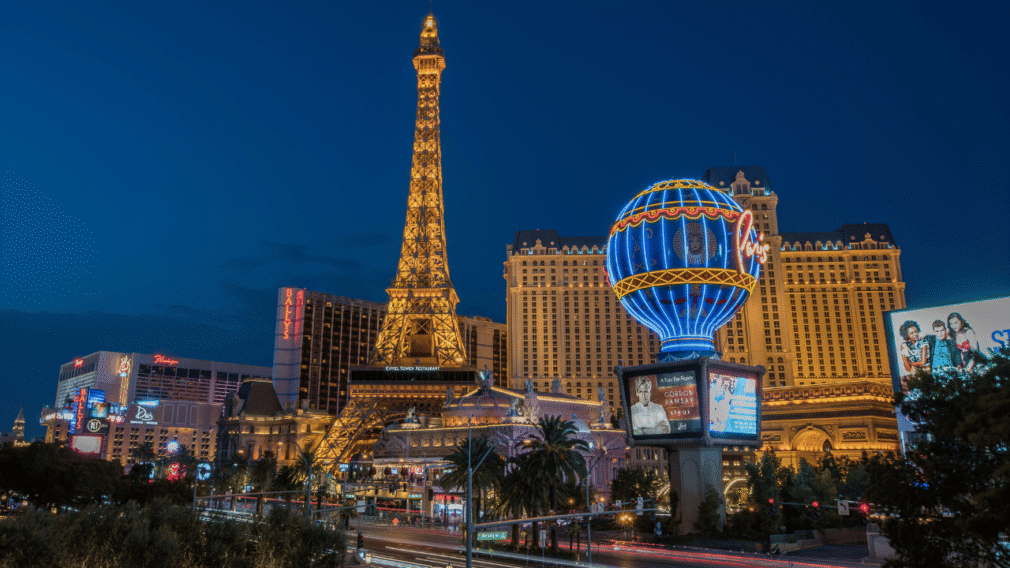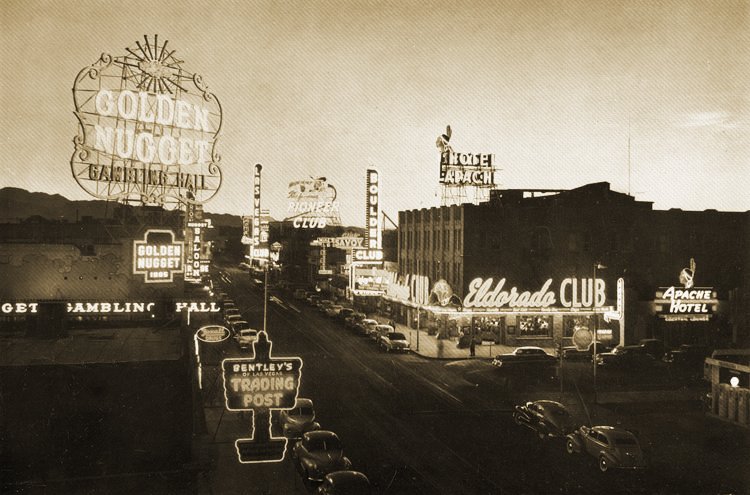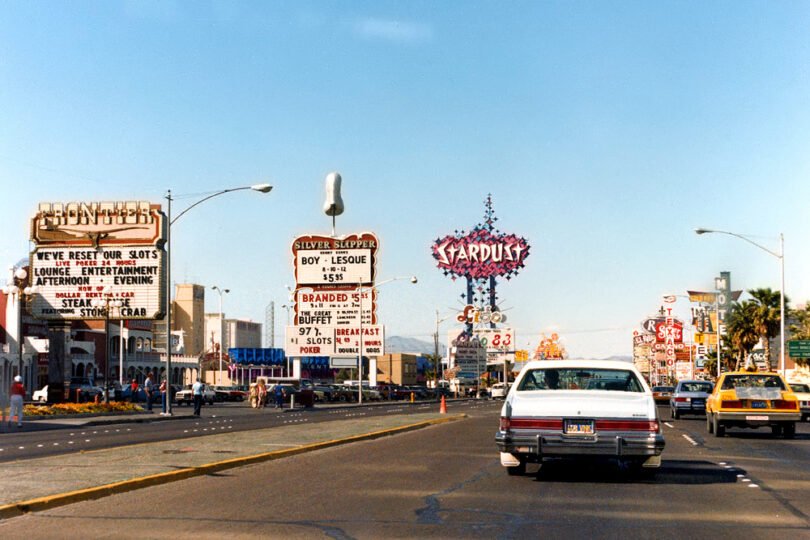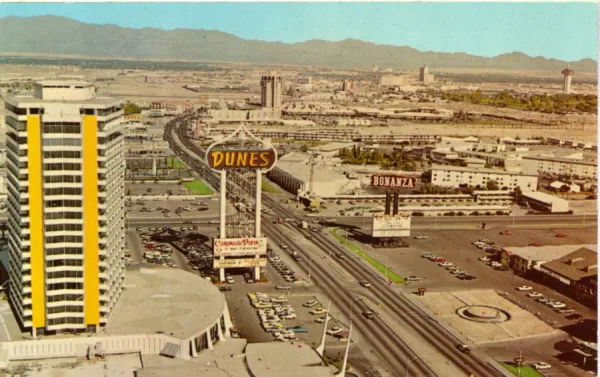The First Casino on the Las Vegas Strip: A Historical Overview

The Las Vegas Strip, a dazzling stretch of Las Vegas Boulevard South in Clark County, Nevada, stands as the world’s entertainment capital, drawing millions each year to its luxurious hotels, casinos, and show-stopping venues. What began as a dusty roadside along Highway 91 has evolved into a global icon, thanks to the vision of its earliest casinos. The Pair-o-Dice Club, launched on May 5, 1931, was the first to bring gambling to this soon-to-be-legendary corridor, hinting at the potential of the area.
A decade later, El Rancho Vegas, opened on April 3, 1941, redefined the game by blending gaming, dining, entertainment, and resort-style amenities, setting the blueprint for the Strip’s modern resorts. Diving into the stories of these trailblazers: Pair-o-Dice and El Rancho Vegas sheds light on how a remote highway became a cultural juggernaut, with their legacy still shining in the grandeur of today’s Strip.
The Birth of the Las Vegas Strip
Tucked in the Mojave Desert, Las Vegas, once a humble oasis dubbed “The Meadows” for its freshwater springs, started as a pit stop for westward travelers in the 19th century. By 1905, it became a proper city with the arrival of the railroad linking Los Angeles to Salt Lake City, but its early years were rough, marked by illegal gambling, drinking, and vice, with little promise of grandeur.
Everything changed in 1931 when Nevada legalized gambling, thanks to Governor Fred Balzar’s signing of Assembly Bill 98, making the state a haven for legal betting just as underground casinos were thriving. At the same time, the Hoover Dam’s construction from 1931 to 1936 poured thousands of workers and millions in federal cash into the region; $70 million of the project’s $175 million budget flowed directly into Las Vegas.
The dam didn’t just bring jobs; it secured water and power, setting the stage for the city’s growth. With workers and tourists flooding in, local entrepreneurs saw a goldmine, opening casinos to lighten the wallets of dam workers and visitors. As downtown Las Vegas got crowded and pricier, attention shifted to Highway 91, a stretch of road south of the city in unincorporated Clark County.
Cheap land and fewer taxes made it perfect for sprawling developments, kicking off with the Pair-o-Dice Club in 1931 and El Rancho Vegas in 1941. This mix of legal gambling, a cash-flush workforce, and wide-open land turned a dusty highway into the budding Las Vegas Strip.

The Pair-o-Dice Club: The First Gambling Outpost
In the spring of 1931, the Pair-o-Dice Club opened its doors on Highway 91, roughly two miles south of downtown Las Vegas, near where Las Vegas Boulevard now meets Fashion Show Drive. Launched on May 5, just weeks after Nevada legalized gambling, this unassuming nightclub became the first casino on what would eventually be the Las Vegas Strip.
With a modest setup featuring a roulette table, a craps table, and a blackjack table, it offered a taste of legal gaming alongside live entertainment and, notably, alcohol, served discreetly before Prohibition’s repeal in 1933 and openly with beer thereafter.
Though small compared to the lavish resorts that followed, the Pair-o-Dice proved Highway 91 could draw gamblers, setting the stage for the Strip’s rise. In 1938, the club changed hands, landing with Guy McAfee, a former Los Angeles police captain turned nightclub operator. McAfee gave it a Hollywood-style makeover, reopening it in 1939 as the 91 Club, complete with swanky interiors, a live orchestra, and budget-friendly steak dinners aimed at Southern California’s elite.
McAfee’s influence went beyond aesthetics. He’s credited with nicknaming the area “The Strip,” inspired by LA’s Sunset Strip. By 1941, the property was sold again, folding into the Hotel Last Frontier, which opened in 1942 as the Strip’s second resort and fourth casino, cementing the Pair-o-Dice’s role as a quiet but pivotal trailblazer.
El Rancho Vegas: Pioneering the Resort-Casino Model
On April 3, 1941, El Rancho Vegas swung open its doors, ushering in a new era for the Las Vegas Strip as the first true resort-casino. Brainchild of Thomas Hull, a California hotelier with a knack for motor inns, the resort was sparked by a 1940 visit to Las Vegas, where local businessmen saw untapped potential.
Designed by architect Wayne McAllister, El Rancho Vegas blended a Spanish mission-style exterior with a cowboy-themed interior, originally envisioned with a pyramid-topped tower and 80 rooms but scaled back to 65 bungalows due to budget constraints.
This suburban-style complex, with its casino, steakhouse, and showroom at the heart, surrounded by car-accessible cottages with private lawns, was a game-changer, catering to vacationing middle-class families rather than locals. It boasted a dazzling array of amenities: gaming tables for craps, blackjack, and roulette, a sparkling pool to lure highway travelers, horseback riding, a health club, a western clothing shop, and a barbershop.
The showroom dazzled with acts like Dean Martin and Sammy Davis Jr., while Gloria Dea made history as the Strip’s first magician in May 1941. In 1946, the resort introduced the now-iconic all-you-can-eat buffet, dubbed the Midnight Chuck Wagon, cementing a Las Vegas tradition.
Hull’s vision of a self-contained oasis, blending gambling, dining, entertainment, and relaxation, set a bold new standard, making El Rancho Vegas the blueprint for the Strip’s future giants.
Comparative Analysis: Pair-o-Dice vs. El Rancho Vegas
The Pair-o-Dice Club and El Rancho Vegas, though both trailblazers on the Las Vegas Strip, carved out distinct paths in its early days. The Pair-o-Dice, opening in May 1931, was a cozy nightclub with a simple setup: a roulette table, a craps table, a blackjack table, and booze. served on the sly before Prohibition ended.
It had no rooms or grand amenities, just a lively vibe that hinted at Highway 91’s gambling potential. In contrast, El Rancho Vegas, launched in April 1941, was a full-blown resort-casino, packing a casino with diverse games, 65 bungalows, a steakhouse, a showroom hosting stars like Sammy Davis Jr., a highway-visible pool, horseback riding, and the game-changing all-you-can-eat buffet introduced in 1946.
While Pair-o-Dice, later revamped by Guy McAfee as the 91 Club, drew wealthy Californians and laid early groundwork, El Rancho’s all-in-one suburban resort model, catering to vacationing families, sparked a development boom, birthing the Strip as a resort corridor.
The debate over the “first casino” title hinges on definitions: Pair-o-Dice was the first to offer gambling on Strip land, but El Rancho redefined what a casino could be, blending gaming, lodging, and entertainment. Together, they complement each other, with Pair-o-Dice planting the seed and El Rancho building the blueprint for the Strip’s enduring legacy.
The Broader Impact on the Strip’s Development
The Pair-o-Dice Club and El Rancho Vegas didn’t just launch the Las Vegas Strip; they ignited a transformation that turned a barren highway into a global entertainment powerhouse. The Pair-o-Dice, opening in 1931, proved Highway 91 could draw gamblers, evolving under Guy McAfee’s glitzy 91 Club and later merging into the Hotel Last Frontier in 1942.

El Rancho Vegas, debuting in 1941, took it further, pioneering the all-in-one resort model with gaming, lodging, dining, and entertainment, inspiring a wave of developments like the Last Frontier and the Flamingo in 1946, the latter driven by Bugsy Siegel’s lavish vision and mob-backed funds.
These early successes were fueled by Nevada’s 1931 gambling legalization, the Hoover Dam’s influx of workers and tourists, Prohibition’s end in 1933, and the post-World War II car-travel boom from California, perfectly suiting El Rancho’s suburban resort style.
Yet, the Strip’s rise wasn’t without shadows; figures like McAfee, a former cop with a murky past, and Siegel, tied to organized crime, brought financing and influence, with mob money shaping early casinos through front businesses.
Siegel’s Flamingo, though over budget and tied to his 1947 death, elevated the Strip’s luxury appeal. As regulations tightened and corporate players like Howard Hughes entered in the 1960s, mob influence faded, but the groundwork laid by Pair-o-Dice’s modest start and El Rancho’s bold resort vision, amplified by economic, social, and cultural tailwinds, set the stage for the Strip’s ascent as the world’s entertainment capital.
The Legacy of the First Casinos
The Pair-o-Dice Club and El Rancho Vegas, though gone from the Las Vegas Strip’s skyline, left an indelible mark on its identity and worldwide fame. The Pair-o-Dice, born in 1931, was absorbed into the Hotel Last Frontier by 1942 after evolving into Guy McAfee’s 91 Club, proving small ventures could spark bigger dreams.
El Rancho Vegas, the Strip’s first full-fledged resort-casino in 1941, met a fiery end in 1960, its main building reduced to ashes and never rebuilt, with its land later sold to Howard Hughes in 1970. Yet, their impact endures. El Rancho’s groundbreaking all-in-one resort model, merging gaming, lodging, dining, and entertainment, became the gold standard, inspiring the Strip’s resort corridor and shaping North America’s casino industry.

The Last Frontier, incorporating Pair-o-Dice’s legacy, pioneered thematic marketing with its “Old West in Modern Splendor” vibe, a precursor to today’s immersive resorts like Caesars Palace or The Venetian. Fueled by 1931’s gambling legalization, the Hoover Dam’s economic jolt, Prohibition’s repeal, and post-war car culture, these early casinos, alongside mob-linked figures like Bugsy Siegel, whose Flamingo added upscale flair, turned a desert road into a glitzy destination.
Modern mega-resorts echo their vision, offering self-contained worlds with casinos, hotels, dining, and entertainment, while thematic designs and a focus on guest comfort carry forward their DNA. Despite the shift from mob money to corporate cash by the 1960s, the Strip’s luxurious, entertainment-driven ethos, rooted in Pair-o-Dice’s humble start and El Rancho’s bold innovation, continues to captivate millions, cementing its status as a global icon.
Conclusion
The Las Vegas Strip, a glittering beacon of entertainment, owes its storied rise to the daring vision of pioneers like the Pair-o-Dice Club and El Rancho Vegas. The Pair-o-Dice, opening in 1931, lit the first spark, proving a dusty stretch of Highway 91 could draw gamblers, its legacy carried forward through Guy McAfee’s 91 Club and into the Hotel Last Frontier.
El Rancho Vegas, bursting onto the scene in 1941, redefined the game with Thomas Hull’s all-in-one resort model, blending gaming, bungalows, dining, star-studded shows, and the iconic all-you-can-eat buffet, inspiring a flood of resorts that birthed the Strip’s identity.
Their influence echoes in today’s mega-resorts, where self-contained luxury, immersive themes pioneered by the Last Frontier, and guest-focused innovation remain king, even as non-gaming revenue like dining and entertainment, foreshadowed by El Rancho, grows.
Shaped by 1931’s gambling legalization, the Hoover Dam’s economic surge, and early mob funding from figures like Bugsy Siegel, the Strip evolved from western roots to neon giants and fantasy-themed colossuses, with corporate giants like Howard Hughes later steering it from its shadowy past.
Though their buildings are gone, replaced in the Strip’s relentless quest for the next big thing, the Pair-o-Dice and El Rancho’s entrepreneurial spirit lives on. To marvel at the Strip’s modern splendor is to stand on the shoulders of these trailblazers, whose gamble on a desert dream built a global icon.
Recommended
